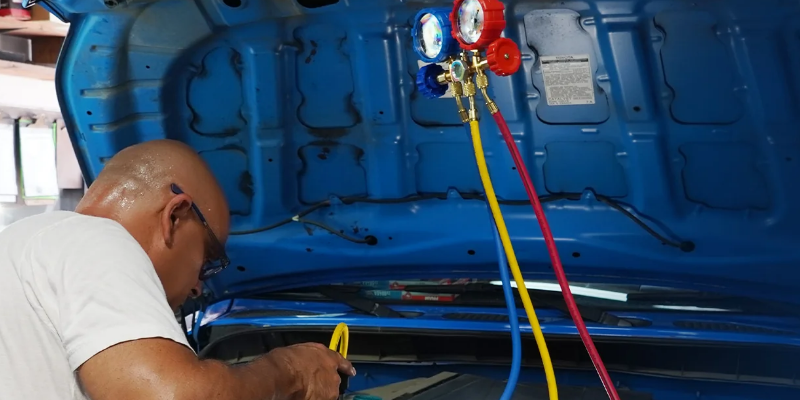Air conditioning systems play a vital role in maintaining a comfortable environment. However, these systems require regular maintenance and occasional repairs to ensure optimal performance. One crucial aspect of AC maintenance is pulling a vacuum, which involves removing air and moisture from the system before testing, repairs, or recharging. This process is typically performed by HVAC professionals, but if you're interested in doing simple at-home repairs, learning to use vacuum pump can be helpful.
This guide outlines the essential steps involved in using AC gauges and a vacuum pump, ensuring effective and efficient AC system vacuuming. Here are the steps involved in using a vacuum pump for air conditioning repairs.
- Fill the pump with vacuum oil: Before using the vacuum pump, ensure that it is filled with clean vacuum pump oil. Unscrew the oil fill cap located on the top of the pump and fill the opening with oil until it reaches the fill line. Use only oil specifically meant for vacuum pumps to maintain their quality and performance.
- Attach your gauges to the ports: You'll need a gauge set that connects to both the vacuum and pressure ports on your AC system. The blue gauge and hose connect to the low-pressure service port, while the red gauge and hose connect to the high-pressure port. The yellow hose connects the gauges to the vacuum. Ensure that all gauges and gauge hoses are tightly connected to prevent any leaks.
- Open the manifold valves: The manifold valves on your AC system open and close the service port to the refrigerant lines. Close the valves, and you should see little to no pressure reading on your gauges.
- Start the vacuum pump: Once all connections are secure, use the switch device on your vacuum pump to turn it on. You should hear the vacuum running once it's switched on.
- Open the gauge valves: To start pulling the vacuum, open the gauge valves located on the side of each gauge. This allows the vacuum to begin pulling air out of the system. If you're unsure which way to turn the valves to open them, consult the manual that came with your gauges or vacuum.
- Allow the vacuum to run: Let the vacuum run at its full operating speed for at least 15 minutes, and up to 30 minutes, to completely remove the air from your AC system. The recommended time may vary based on manufacturer guidelines, so refer to operational manuals for your AC system and vacuum pump. Ideally, aim to achieve a measurement below 1,000 microns, with a target of reaching 500 microns if possible.
- Close the low-side valve and hold the vacuum: Once the vacuum has been running for a sufficient amount of time, close the valve that connects to the low-side gauge. Allow the pump to hold the vacuum for 15 minutes. If it's unable to hold the vacuum for that duration, it may indicate a leak and require replacement components for the vacuum pump.
- Shut off the vacuum pump: When you're satisfied with how long the system has held the vacuum, use the switch mechanism to shut off the vacuum pump. Wait for the vacuum to disengage completely before disconnecting the system.
- Disconnect the vacuum: Once the vacuum has fully disengaged, disconnect the hose leading to the pump. At this point, your AC system should be fully evacuated, ready for recharging or repairs.

How to Determine if There is a Leak
Observe the pressure readings: Monitor the pressure gauge readings and note any fluctuations or drops in pressure. If the pressure drops significantly, it indicates a potential leak in the system.
How to Find the Leak
Inspect potential leak points: Pay close attention to areas where leaks commonly occur, such as joints, connections, valves, and seals. Visually inspect these points for signs of air or fluid leakage, such as bubbles, hissing sounds, or wet spots.
Utilize leak detection methods: Depending on the system and the type of leaks you are looking for, you can employ various techniques to detect leaks. Some common methods include using a soapy water solution to identify air bubbles when it comes in contact with a leak, using a sniffer device to detect specific gas leaks, or employing thermal imaging cameras to identify temperature variations caused by leaking fluids.
How to Fix the Leak
Address leaks: Once leaks are identified, mark their locations and prioritize them based on severity. Repair or replace the defective components or take necessary steps to fix the leaks.
Retest the system: After addressing the leaks, repeat the pressurization process to ensure that all issues have been resolved and the system is leak-free.
In addition to using a vacuum pump and manifold gauge set, there are other regular maintenance tasks you can perform to keep your air conditioning system running smoothly. Cleaning drain issues with a Co2 drain gun and AC drain brush, regularly replacing filters, and using condensate pan tablets to prevent drain clogs are all important steps. For all your air conditioning maintenance needs, Orion Motor Tech offers a wide selection of high-quality vacuum pump and manifold gauge sets.


